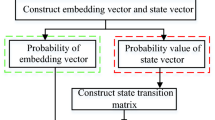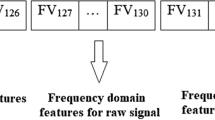Abstract
Automotive engine knock is an abnormal combustion phenomenon that affects engine performance and lifetime expectancy, but it is difficult to detect. Collecting engine vibration signals from an engine cylinder block is an effective way to detect engine knock. This paper proposes an intelligent engine knock detection system based on engine vibration signals. First, filtered signals are obtained by utilizing variational mode decomposition (VMD), which decomposes the original time domain signals into a series of intrinsic mode functions (IMFs). Moreover, the values of the balancing parameter and the number of IMF modes are optimized using genetic algorithm (GA). IMFs with sample entropy higher than the mean are then selected as sensitive subcomponents for signal reconstruction and subsequently removed. A multiple feature learning approach that considers time domain statistical analysis (TDSA), multi-fractal detrended fluctuation analysis (MFDFA) and alpha stable distribution (ASD) simultaneously, is utilized to extract features from the denoised signals. Finally, the extracted features are trained by sparse Bayesian extreme learning machine (SBELM) to overcome the sensitivity of hyperparameters in conventional machine learning algorithms. A test rig is designed to collect the raw engine data. Compared with other technology combinations, the optimal scheme from signal processing to feature classification is obtained, and the classification accuracy of the proposed integrated engine knock detection method can achieve 98.27%. We successfully propose and test a universal intelligence solution for the detection task.















Similar content being viewed by others
References
Zhen X, Wang Y, Xu S, Zhu Y, Tao C, Xu T, Song M. The engine knock analysis-an overview. Appl Energy. 2012;92:628–36.
Galloni E. Dynamic knock detection and quantification in a spark ignition engine by means of a pressure based method. Energy Convers Manage. 2012;64:256–62.
Abu-Qudais M. Exhaust gas temperature for knock detection and control in spark ignition engine. Energy Conversion and Management. 1996;37(9):1383–1392.
Ollivier E, Bellettre J, Tazerout M, Roy CG. Detection of knock occurrence in a gas SI engine from a heat transfer analysis. Energy Conv Manage. 2006;47(7-8):879–893.
Pan J, Shu G, Wei H. Interaction of flame propagation and pressure waves during knocking combustion in spark-ignition engines. Combust Sci Technol. 2014;186(2):192–209.
Yao J, Xiang Y, Qian S, Wang S, Wu S. Noise source identification of diesel engine based on variational mode decomposition and robust independent component analysis. Appl Acoust. 2017;116:184–94.
Luo J, Vong CM, Wong PK. Sparse bayesian extreme learning machine for multi-classification. IEEE Transactions on Neural Networks and Learning Systems. 2014;25(4):836–43.
Wong KI, Vong CM, Wong PK, Luo J. Sparse bayesian extreme learning machine and its application to biofuel engine performance prediction. Neurocomputing. 2015;149:397–404.
Wong PK, Zhong JH, Yang ZX, Vong CM. A new framework for intelligent simultaneous-fault diagnosis of rotating machinery using pairwise-coupled sparse Bayesian extreme learning committee machine. Proceedings of the Institution of Mechanical Engineers Part-C: Journal of Mechanical Engineering Science. 2016;231(6):1146–61.
Kearney MJ. Knock signal conditioning using the discrete fourier transform and variable detection window length. Tech. Rep. No. 2007-01-1509, SAE. 2007.
Vulli S, Dunne J, Potenza R, Richardson D, King P. Time-frequency analysis of single-point engine-block vibration measurements for multiple excitation-event identification. J Sound Vib. 2009;321:1129–43.
Chang J, Kim M, Min K. Detection of misfire and knock in spark ignition engines by wavelet transform of engine block vibration signals. Meas Sci Technol. 2002;13:1108–14.
Zhang Z, Tomita E. Knocking detection using wavelet instantaneous correlation method. JSAE Rev. 2002;23:443–9.
Borg JM, Saikalis G, Oho S. Knock signal analysis using the discrete wavelet transform. Tech. Rep. No. 2006-01-0226, SAE. 2006.
Yang JG, Liu XF, Lin B. DWT based knock detection and knock intensity judgment for a gasoline engine. Transactions of Chinese Society for Internal Combustion Engines. 2003;21(3):233–8.
Li N, Yang J, Zhou R, Wang Q. Knock detection in spark ignition engines using a nonlinear wavelet transform of the engine cylinder head vibration signal. Meas Sci Technol. 2014;25.
Wong PK, Hua Zhong J, Yang Z, Vong CM. Sparse bayesian extreme learning committee machine for engine simultaneous fault diagnosis. Neurocomputing. 2016;174:331–343.
Huang NE, Shen Z, Long SR, Wu MC, Shih HH, Zheng Q, Yen NC, Tung CC, Liu HH. The empirical mode decomposition and the Hilbert spectrum for nonlinear and non-stationary time series analysis. Proceedings of Royal Society A: Mathematical, Physical and Engineering Science. 1998;454:903–95.
Bi F, Ma T, Zhang J, Li L, Shi C. Knock detection in spark ignition engines base on complementary ensemble empirical mode decomposition-hilbert transform. Shock Vib. 2016;2016:9507540.
Chen F, Chen X, Yang Z, Xu B, Xie Q, Zhang H, Ye Y. A rolling bearing fault diagnosis method based on VMD-multiscale fractal dimension/energy and optimized support vector machine. Journal of Vibroengineering. 2016;18(6):3581–95.
Wang XB, Yang ZX, Yan XA. Novel particle swarm optimization-based variational mode decomposition method for the fault diagnosis of complex rotating machinery. IEEE/ASME Trans Mechatron. 2017;23(1):68–79.
Bi F, Li X, Lin J, Bi X, Ma T, Yang X, Tang D, Shen P. Knock detection based on recursive variational mode decomposition and multilevel semi-supervised local fisher discriminant analysis. IEEE Access. 2019;7:122028–40.
Zhang M, Jiang Z, Feng K. Research on variational mode decomposition in rolling bearings fault diagnosis of the multistage centrifugal pump. Mech Syst Signal Process. 2017;93:460–93.
Yentes JM, Hunt N, Schmid KK, Kaipust JP, McGrath D, Stergiou N. The appropriate use of approximate entropy and sample entropy with short data sets. Ann Biomed Eng. 2013;41(2):349–65.
Richman JS, Moorman JR. Physiological time-series analysis using approximate entropy and sample entropy. J Mech Sci Technol. 2000;278(6):H2039–49.
Duin RP. The combining classifier: to train or not to train? In: Object recognition supported by user interaction for service robots. 2002;2:765–770.
Fu W, Zhou J, Zhang Y. Fault diagnosis for rolling element bearings with VMD time-frequency analysis and SVM. In: 2015 Fifth International Conference on Instrumentation and Measurement, Computer, Communication and Control (IMCCC). 2015;69–72.
Kang Y, Wang CC, Chang YP. Gear fault diagnosis by using wavelet neural networks. In: International Symposium on Neural Networks. 2007;580–588.
Huang GB, Zhou H, Ding X, Zhang R. Extreme learning machine for regression and multiclass classification. IEEE Transactions on Systems, Man, and Cybernetics, Part B (Cybernetics) 2012;42(2):513–529.
Vong CM, Tai KI, Pun CM, Wong PK. Fast and accurate face detection by sparse bayesian extreme learning machine. Neural Comput Appl. 2015;26(5):1149–56.
Sujono A, Santoso B, Juwana WE. Sound Vibration Signal Processing For Detection and Identification Detonation (Knock) To Optimize Performance Otto Engine. AIP Conf Proc. 2016;1717(1).
Bi F, Ma T, Wang X. Development of a novel knock characteristic detection method for gasoline engines based on wavelet-denoising and EMD decomposition. Mech Syst Signal Process. 2019;117:517–36.
Roy A, Manna A, Maity S. A novel memetic genetic algorithm for solving traveling salesman problem based on multi-parent crossover technique. Decision Making: Applications in Management and Engineering. 2019;2(2):100-11.
Biswas P, Pal BB. A fuzzy goal programming method to solve congestion management problem using genetic algorithm. Decision Making: Appl Manage Eng. 2019;2(2);36–53.
Yi C, Lv Y, Dang Z. A fault diagnosis scheme for rolling bearing based on particle swarm optimization in variational mode decomposition. IEEE Trans Signal Process. 2016;2016:9372691.
Pincus SM. Approximate entropy as a measure of system complexity. Proc Natl Acad Sci. 1991;88(6):H2297–301.
Wei Z, Wang Y, He S, Bao J. A novel intelligent method for bearing fault diagnosis based on affinity propagation clustering and adaptive feature selection. Knowl-Based Syst. 2017;116:1–12.
Xiong Q, Xu Y, Peng Y, Zhang W, Li Y, Tang L. Low-speed rolling bearing fault diagnosis based on EMD denoising and parameter estimate with alpha stable distribution. J Mech Sci Technol. 2017;31(4):1587–601.
Mali P, Sarkar S, Ghosh S, Mukhopadhyay A, Singh G. Multifractal detrended fluctuation analysis of particle density fluctuations in high-energy nuclear collisions. Physica A. 2015;424:25–33.
Banerjee KS. Generalized inverse of matrices and its applications. Technometrics. 1973;15(1):197–197.
Acknowledgements
This authors would like to thank the financial support from the University of Macao Distinguished Visiting Scholar Program. This research is funded by the Science and Technology Development Fund, Macau SAR (Nos. 0021/2019/A, 0018/2019/AKP, 0008/2019/AGJ), the Multi-Year Research Grant(No.MYRG2019-00137-FST), the National Natural Science Foundation of China (Nos. 61976172, 12002254) and the Natural Science Basic Research Program of Shaanxi (Nos. 020JQ-013, 2020JM-072). This work is also supported in part by the Macao Youth Scholars Program (No. AM201909).
Author information
Authors and Affiliations
Corresponding author
Ethics declarations
Ethical Approval
This article does not contain any studies with human or animal subjects performed by any of the authors.
Informed Consent
Informed consent was not required as no human or animals were involved.
Conflict of Interest
The authors declare that they have no conflict of interest.
Additional information
Publisher’s Note
Springer Nature remains neutral with regard to jurisdictional claims in published maps and institutional affiliations.
Rights and permissions
About this article
Cite this article
Yang, ZX., Rong, HJ., Wong, P.K. et al. A Novel Multiple Feature-Based Engine Knock Detection System using Sparse Bayesian Extreme Learning Machine. Cogn Comput 14, 828–851 (2022). https://doi.org/10.1007/s12559-021-09945-3
Received:
Accepted:
Published:
Issue Date:
DOI: https://doi.org/10.1007/s12559-021-09945-3




